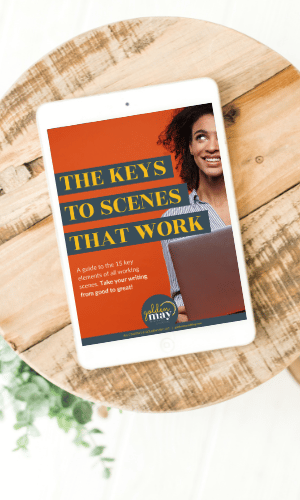As much as we think we do, we don’t actually read action scenes for the action. We don’t read romance for the kissing scenes. We’re not sucked into stories because we want to know what crazy stuff will happen in the plot. Rather, we’re glued to the pages of stories when we’re dying to know what characters we’ve come to love will do when faced with crazy plot events.
We are MOST attracted to characters who change over the course of a story, characters who are forced to face their flaws, because these characters are unpredictable.
When crazy shit happens, we don’t know what they’re going to do. What will the character in the action story sacrifice to obtain their goals? How far will those lovers in the romance bend to achieve long lasting love?

If you want your readers to obsess over your characters, stay up all night devouring your words, and then spend their precious time and money shouting about your story to all their friends, you must pose this question in every scene, and answer it at the climax of your story.
To achieve any of this, you need to start by giving your character a strong Internal Obstacle.
What is an Internal Obstacle?
Your character’s Internal Obstacle is the lie, misbelief, or worldview that they need to unlearn in order to achieve their goals. It should be a succinct, one line false belief about how the world works. During the story, your character may think their problems are external, but until they overcome this character flaw at the climax of the story, they cannot succeed. Their Internal Obstacle should be in contrast to your Story’s Point.
For example, in An Ember in the Ashes by Sabaa Tahir, Laia of Serra’s Internal Obstacle is her belief that “some people are inherently strong, others weak,” which is in direct contrast to the Story’s Point that “Your power lies in your hands, and your hands only.”
Why is an Internal Obstacle Important?
The answers are endless, but let’s start with the top four reasons you should give your main character an Internal Obstacle. I’ll use Laia from An Ember in the Ashes to prove how it works!
1. An Internal Obstacle can help you develop your character’s motivations.
To engage readers, your protagonist needs deep, passionate goals that they’re willing to fight and change for—and they need to conflict. There’s the external plot goal that they consciously desire and an internal character goal that they wrongly think their external goal will give them. Their Internal Obstacle is the dissonance between these two goals—so you can work backwards to figure what incompatible goals their false beliefs might lead them to chase.
In Ember, Laia’s Internal Goal is to save her brother from prison because she feels like she is the reason he got captured (because she was too weak to save him). Because of her Internal Obstacle belief that she’s inherently weak, however, she doesn’t consider saving him herself. Instead, her External Goal becomes finding and convincing Resistance fighters to save her brother—strangers who ultimately betray her.
2. An Internal Obstacle can help you determine your plot.
The plot of your story should constantly challenge your character’s Internal Obstacle. Shove your character into corners, force them to choose repeatedly between upholding their flawed Internal Obstacle or finally dismantling it. Each time they fail to change, there should be consequences that further complicate the plot. As you’re planning your story, consider what plot events will most trigger your character’s internal obstacle at every turn.
In Ember, Laia’s failure to believe in her own power drives her to beg the Resistance to rescue her brother. They agree to help, but only if she spies for them. Laia agrees, but during her mission she fails to believe in herself over and over again. The plot forces her to pick courage or cowardice at every turn—each time she fails there are consequences, for herself and for her brother’s chances at rescue.
3. An Internal Obstacle can help you decide how to START & END the story.
We love stories in which characters change. As such, the opening and closing of the story provide us with the clearest opportunities to show us that change through a decision point, because actions speak louder than words! Both the Inciting Incident and Climax moments of your story should provide your character with a choice: Will they uphold their Internal Obstacle, or prove they’ve overcome it? At the beginning, they’ll fail. At the end, they’ll finally dismantle their Internal Obstacle and succeed (at least in a positive arc story!).
In Ember, Laia’s Inciting Incident is when her brother is captured. She escapes and then needs to make a choice. Will she find the Resistance to save her brother (upholding her internal obstacle) or try to save him on her own (overcoming her internal obstacle)? She chooses to look for the Resistance, failing to overcome her Internal Obstacle—which has huge consequences later.
At the end of the story Laia realizes that the Resistance tricked her and never planned to help her save her brother. By trusting them, she wasted valuable time she could have used to look for her brother. When the Resistance tries to kill her, Laia’s friend saves her with a promise to get her to safety and save her brother himself—but she’d have to leave her new friends behind in serious danger, friends who helped her with her fake spy mission. Again, Laia faces a hard choice: Will she let this friend take care of her and save her brother (believing herself weak) or save her other friends and try to save her brother on her own (believing herself capable)? Laia chooses to save her friends and forego the offer, proving that she’s finally overcome her Internal Obstacle and now believes in herself. (And proving the story’s point that Your power is in your hands and your hands only!)
4. You can use your main character’s Internal Obstacle to craft powerful secondary characters and antagonists.
The best side characters in a story serve to mirror or challenge your main character’s internal journey or flaws. Antagonists are effective when they struggle against the same Internal Obstacle as the main character but fail to overcome it. Side characters who have already learned the Internal Obstacle can help teach it. Romance partners who are struggling with similar, or opposite, struggles can provide lots of turmoil. As you’re planning your secondary characters, consider how they can mirror, challenge, or complicate your character’s Internal Obstacle. Who can they learn from? And how?
In Ember, every character struggles with power, responsibility, and confidence in their own way. Her slave friend Isi seems weaker than Laia, and yet she insists on helping with the spy mission anyway. Their joint overseer, Cook, has given up on hope entirely until Laia convinces her otherwise. The story’s love interest, Elias, feels completely powerless in his own way, together he and Laia discover that their powerlessness is a facade.
Giving your character a deep flaw, a false belief about how the world works, gives them a level of unpredictability that readers love. We are rooting for them to change, and thrive on the thrill of not knowing if they will. Internal Obstacles are what keep readers flipping pages—AND they can help a writer shape a cohesive story that conveys a particular message in many innovative ways.








This summary really helped me reflect on my characters inner flaw. I was able to make it more concise by envisioning and articulating his flaw to myself in the right way to mirror how he must change. It was a subtle thing but it really helped. Thank you ladies!
That’s so wonderful, Anne! We’re glad it helped you out. Thanks for reading 🙂
[…] something is standing in their way of getting it (obstacles). Until the protagonist overcomes their internal obstacle, and unlearns the misbelief/lie that is holding them back, they will not be able to achieve their […]
I read articles with a similar message frequently, but I still don’t buy into the concept of characters overcoming internal obstacles, having positive change arcs, etc. as being crucial to a story. I don’t engage with a character just because they have a flaw, I engage with them for any variety of reasons – their character, beliefs, personality, etc. And then I want them to “win”.
I realize this is not the accepted view and that I may be wrong, but I don’t relate to the “overcome internal flaws” concept.
Would there ever be a main character who doesn’t overcome his internal obstacle? Struggling a bit with mine…